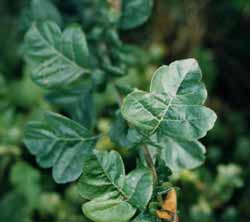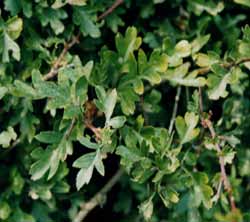![]()
How to date hedges
Origin of hedges
Enclosed areas of land are known in Cornwall from the Bronze Age, while in Sussex, Kent and Norfolk some fields have been interpreted as being of Roman origin. Field boundaries from these times were earth ridges or made of stones, but it is likely that even then dead hedges were being built. These were wattle-type barriers made by weaving wands of young wood around stakes hammered into the ground. These remained the main type of field boundary into and through the Middle Ages. It is not really known when live hedges were first planted, but it is thought that before they were ever planted live hedges came about when seedlings grew along the line of a dead hedge or on an earth mound and were left to develop into a natural, living barrier. Live hedges were almost certainly being created in the late twelfth century when Kings John and Richard enhanced the Royal treasury by leasing assarts (areas of woodland cleared for agriculture) of the Royal Forests. The law required perimeter fences (including hedges) to the fields to be well maintained in order to prevent encroachment onto the fields by the King’s game from the forest.
The practice of enclosing small fields, started in the Bronze Age, is thought to have continued into the Dark Ages, when open fields are thought to have first appeared. The practice of farming strips in very large open fields then grew through the Middle Ages. By Tudor times it was dominant in much of England and most signs of the earlier system of small enclosures had gone.
Even in the part of England, including the East Midlands, where open fields were dominant, enclosure continued locally for very good reasons. However, up to the early seventeenth century there were many Acts of Parliament against enclosure, which was effectively illegal. The first Act of Parliament in support of enclosure, thereby signalling the beginning of the end of the open field system was in 1603 and there were several more in the seventeenth century. This was when live hedges started to be planted in large numbers. In England as a whole the main period of enclosure, though, was between 1760 and 1820. In Nottinghamshire there was frenetic enclosure activity in the periods 1765 to 1775 and from 1790 to about 1820. It effectively ended in the county by1830. For the next century there was relatively little change and then in the late 1940s wholesale grubbing up of hedges began as farmers modernised their practices.
Dating hedges
Hedges are best dated using maps and other documentary sources,
but in their absence a method based on counting species diversity
in 30m stretches of hedge was developed by E.Pollard, M.D.Hooper,
and N.W.Moore and is described in their book Hedges (Collins,
London, 1974). Another useful book, which also describes the
dating method is The History of the Countryside by Oliver
Rackham (J.M.Dent and sons Ltd, London 1986). The method,
commonly described as “Hooper’s Rule”, was
originally presented in the formula:
Age =(no of species in a 30 yard stretch) x 110 +
30 years.
It is usually simplified to counting the different species
of tree or shrub in 30 metre stretches of hedgerow. Several
30 m stretches should be counted in each hedgerow. The average
number of species equates to the age in centuries. It is advisable
not to start counting close to the start of a hedge where
anomalous species may occur and only established hedge plants
are counted, not seedlings.
Soon after publication of the method it was criticised and in an article entitled Understanding Fields by Tom Williamson in the Local Historian (Volume 33, No 1, 2003) he firmly states that it does not work, citing evidence from various sources. At best this method gives an approximation to the age and even supporters who have written about it recommends that it should always be used in conjunction with documentary evidence of age for hedges in the area.
Pollard and his colleagues divided hedges up into two types. One type they called “pure” or “simple”; the other type “mixed”. Pure hedges are those that have one predominant species and will always have been planted. Commonly these are hawthorn hedges that were planted as a single species hedge, though it was not uncommon for elm and other timber trees to be planted as a potential timber crop in the hedgerow alongside the hawthorn. The mixed hedges, which do not generally have any one particular dominating species, have different origins. They are usually old hedges. Some were planted as mixed hedges. This is thought to have been common in early hedges likely to have been made up of different seedlings collected from nearby woodland, but there are examples of early nineteenth century hedges that were deliberately planted as a mixed hedgerow. Two other types of mixed hedgerow have a natural origin. In one type fence lines become colonised with hedgerow plants and are left to develop into a natural, live hedge. In the other the hedges were remnants of recently cleared woodland.
 Midland hawthorn (Crataegus oxycanthoides) with a bigger, far less indented leaf with more rounded lobes than the common hawthorn. The haws, which are redder and more rounded than the common hawthorn, contain two or more seeds. Ornamental forms of this species have pink flowers. Photo: Peter Allen |
Hawthorn
A special factor that has to be taken into account is the presence of two types of hawthorn. These are common hawthorn (Crataegus monogyna) and midland hawthorn ( C. oxyacanthoides). Common hawthorn, which has well dissected leaves, is by far the commoner of the two. Characteristically it is found in the wild state at the margins of woods or in open spaces and is the variety that has been most widely used in planted hedges. Midland hawthorn is a plant typical of mature woodland in the East Midlands. Its leaves are less dissected and bigger than the common hawthorn. Normally, the two species would not grow together, but when they do they hybridise and produce fertile offspring. Thus hybrids are very common and it may be difficult to tell them from the two parent plants. A further complication is that recently planted hedges often contain a Dutch variety of hawthorn, not a native English species, presumably bought in bulk cheaply by the County Council. For these reasons it is usual to lump all varieties of hawthorn together and count them as a single species.
Analysis of the results of the species counts for Bingham
Documentary evidence suggests that there were two periods of enclosure. The first was in Elizabethan times; the second possibly as early as about 1680, but definitely before 1776. Thus, nearly all the hedges in Bingham are older than at least 225 years and the majority may be as old as 325 years.
Using Hooper’s original formula the hedges dating from 1680 should have an average of 2.7 or more if only one type of shrub was planted originally. Of those hedges that are known from maps to pre-date 1776 and fall into this category only 57% have averages of 2.7 or more. 11% have averages less than 1.8.
|
There is evidence that the Earls of Chesterfield did, in fact, plant trees for timber and shade along with hawthorn. Of those hedges in which hawthorn is dominant 60% still contain ash (mostly), oak or elm. Old farmers report that many of the timber trees in hedgerows came down through old age in the 1950s and 1960s and were not replaced. All elm trees, of course, died as a result of Dutch elm disease. Among the pre-1776 hedges with an average of less than 2 species per 30m only 42% have timber trees. There is evidence that these hedges have been modified since they were originally planted. Until the 1970s when the Bingham farmers ceased keeping stock the hedges would have had to have been well maintained and gaps filled. Many hedges contain the remains of old wooden fencing with hawthorn that has never been laid growing through it. Elsewhere, there are hawthorn hedges in which old, laid shrubs are intermixed with quite young bushes that have never been laid. Nearly all the low average hedges look like this.
It seems reasonable to conclude that Hooper’s formula cannot be applied unmodified in Bingham. It is not known what spacing there would have been between plantings of timber and shade trees when the hedges were laid down, but where timber trees survive they occur at less than 100m intervals. If Hooper’s formula is modified to take this into account and a starting average of 1.3 is applied, the hedges dating from 1680 should have an average of 3. In fact only 43% of the pre-1776 hedges have an average of 3 or more.
15 hedges are known to have been planted between 1776 and 1832. Fewer than 40% of them have ash or elm, which may not have been planted with such enthusiasm at this time. Four of them (27%) have an expected average of 1.5.
Finally there are 9 hedges known to be younger than between 1832 and 1850, but are not modern. Four have an average of 3; three an average of 2; two are 1 and 1.2.
It is difficult to know how to interpret these results. If it is valid to modify Hooper’s methodology to take account of initial plantings of timber trees with the hawthorn, then only 43% of the hedges have averages that are consistent with an age based on documentary evidence. Among these are many mixed hedges that may never have had only one species to start with. Moreover, there is no sensible pattern of averages around field boundaries. Four hedges forming the boundary to a field that clearly results from a single pre-1776 enclosure process can show a wide range of averages. Examples are 1.4 to 3; 1 to 2.7; 2.5 to 3.3. An attempt was made to distinguish the hedges that bounded what may have been the original Medieval furlongs, from those of fields within them. There was no clarity here.
Almost certainly many of Bingham’s hedges
have been modified in some way since their original planting, but there
is no documentary evidence to show how this would have affected the basis
for the Hooper formula. It has to be concluded that counting species per
30 metres does allow a crude separation into Elizabethan and later enclosure
hedges, but does not allow further analysis of the ages of hedges in Bingham.

